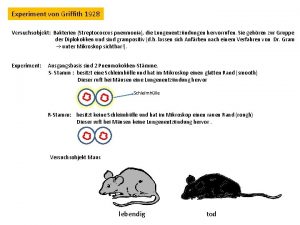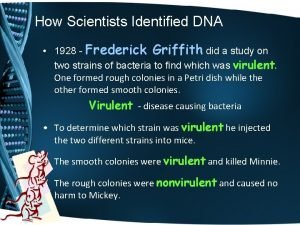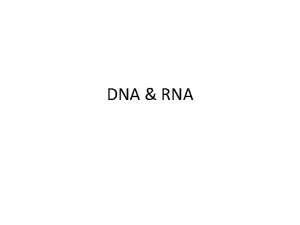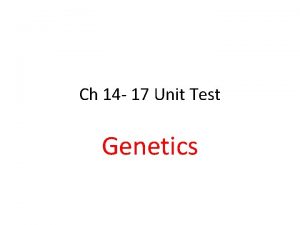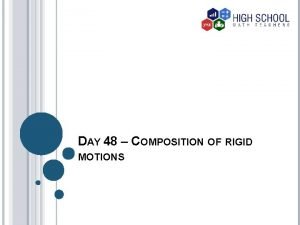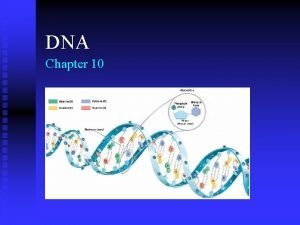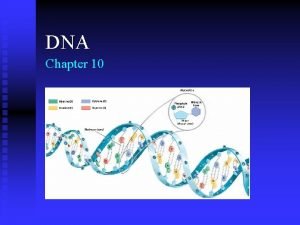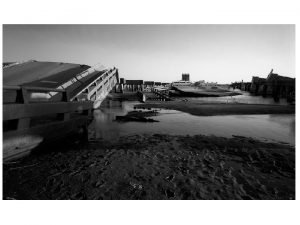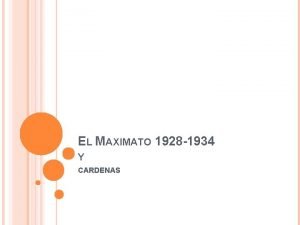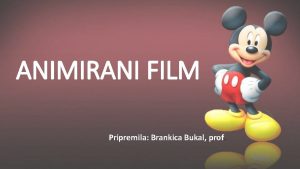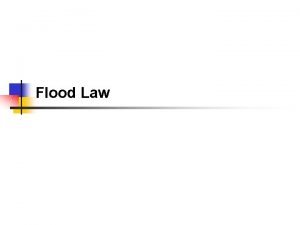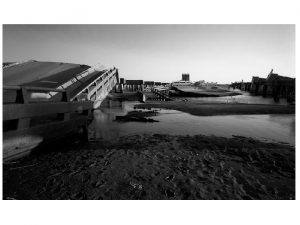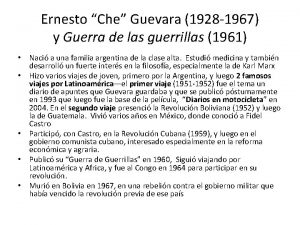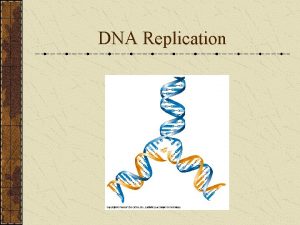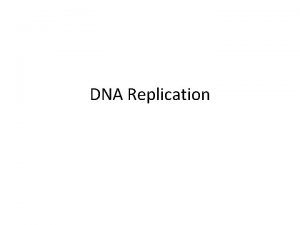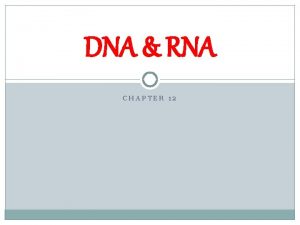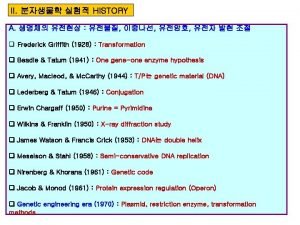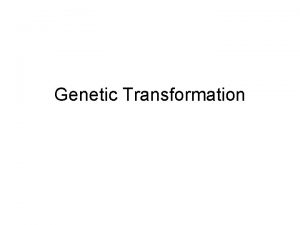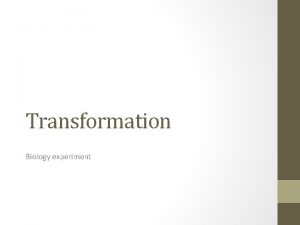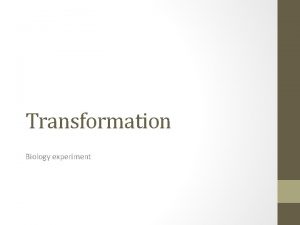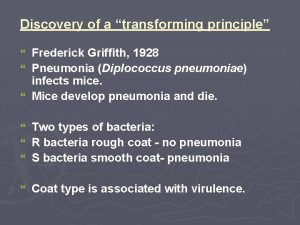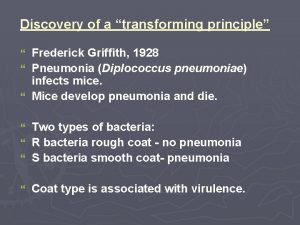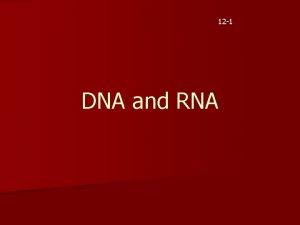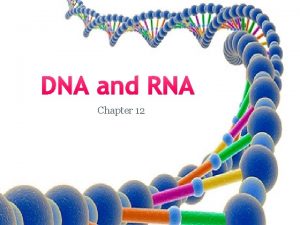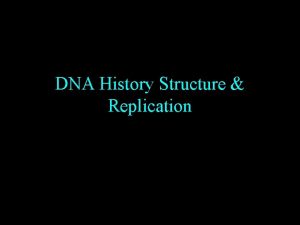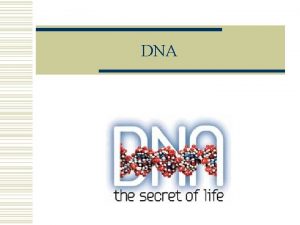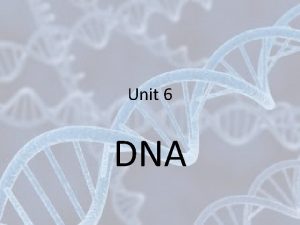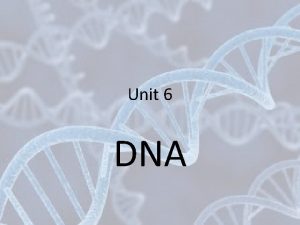DNA Discovery and composition Griffith and Transformation 1928























- Slides: 23

DNA Discovery and composition

Griffith and Transformation 1928 – Frederick Griffith looked at pneumonia bacteria trying to figure out what made people die. S (SMOOTH) strain - killed mice R (Rough) strain -mice lived

Griffith continued If Griffith heated the deadly strain before injecting it into the mice, the mice lived. Why? ?

Griffith continued • If he heated the deadly strain and then mixed it with the harmless strain, the mice died.

Transformation • the heat killed bacteria passed their diseasecausing ability to the harmless strain. • Transformation- one strain of bacteria had been changed permanently into another. • A factor was transferred from the heat killed bacteria into the live cells. What was the factor? ?

Avery and DNA • Avery experimented to find out which factor in the heat killed bacteria was most important for transformation. DNA stores and transmits genetic information from one generation to the next.

Structure of DNA • Discovered by James Watson and Francis Crick in 1953 – Used x-ray photos taken by Rosalind Franklin

Watson and Crick • 1953 - constructed a model of DNA that was a double helix, two strands were wound around each other.

Structure of DNA • DNADeoxyribonucleic Acid • Composed of 2 long chains of nucleotides

Interesting Facts • Human DNA contains 3. 2 billion base units – About 5 cm unwound • There is ~1. 5 billion miles of DNA in your body – 3, 000 round trips to the moon or 600 round trips to the sun • If each nucleotide would represent a letter on a text book page, you could stack the pages 65 feet high

Components of DNA • Nucleotides are made up of 3 components • 5 -carbon sugar (deoxyribose) • Phosphate group • Nitrogenous base DRAW THIS!!!

DNA

Sugar-Phosphate backbone • Sugar and phosphate molecules form the backbone of DNA (sides of the ladder) • Nitrogenous bases are attached to the sugar (steps of the ladder)

DNA directionality Review! • The strands are oriented in opposite directions. • This is the only way the bases can line up to form the hydrogen bonds

5’ 3’ 5’ 3’ refers to the order of the carbons in the deoxyribose sugar

4 types of bases Pyrimidines Cytosine- C Thymine- T Purines Guanine- G Adenine- A

Base-pairing rule • Purines and Pyrimidines join together Base pairing rule A T (T A) G C (C G)

What holds the bases together? ? ? • Hydrogen bonds form between nitrogenous bases • Guanine is held to Cytosine with a triple bond • Adenine is held to Thymine with a double bond

Order of bases • Nucleotides can be joined together in any order (steps of the ladder) – This is what makes organisms different from each other! • Any sequence of bases is possible

Function of DNA • DNA is used to control the cell – It tells the cell how to function • DNA holds the instructions for making proteins – Proteins are used for • • • Antibodies Enzymes Insulin Receptor proteins Cytoskeleton

Interesting facts • Human DNA is 99. 9% identical to each other • 99. 1% to chimps • 90% to mice • 85% to Zebra Fish • 50% to bananas • 21% to worms • 7% to bacteria

Review Quiz 1. What is the primary function of DNA? 2. DNA consists of how many chains? 3. What are the subunits called that make up DNA? 4. Name the 3 parts of a nucleotide. 5. DNA bases are made of rings of carbon and ______. 6. Name the 4 nitrogen bases on DNA. 7. The shape of DNA is known as a ____________.

Review Quiz 11. The sides or backbone of DNA is composed of what 2 things linked together? 12. The center of the helix contains pairs of ______. 13. What type of bonds hold the bases together? 14. Cytosine pairs with ______, while adenine pairs with ____. 15. Base pairs that bond to each other are said to be _______ base pairs. 16. _______ hydrogen bonds join cytosine to guanine, while _______ hydrogen bonds join adenine to thymine.
 Versuch von griffith
Versuch von griffith Monomer of dna
Monomer of dna 1928 griffith
1928 griffith 3 componets of dna
3 componets of dna In his transformation experiments what did griffith observe
In his transformation experiments what did griffith observe Composition of rigid motion
Composition of rigid motion Section 10-1 review discovery of dna
Section 10-1 review discovery of dna Section 10-1 review discovery of dna
Section 10-1 review discovery of dna Coding dna and non coding dna
Coding dna and non coding dna Definition of pakistan studies
Definition of pakistan studies Flood control act of 1928
Flood control act of 1928 Qué es el maximato
Qué es el maximato 1928 magnetic tape
1928 magnetic tape Kolažni animirani film
Kolažni animirani film Flood control act of 1928
Flood control act of 1928 Flood control act
Flood control act 1967-1928
1967-1928 1928 flood control act
1928 flood control act Ariel scheinermann
Ariel scheinermann Replication
Replication Bioflix activity dna replication dna replication diagram
Bioflix activity dna replication dna replication diagram Replication process
Replication process Dna rna protein synthesis homework #2 dna replication
Dna rna protein synthesis homework #2 dna replication Singapore bible college
Singapore bible college
